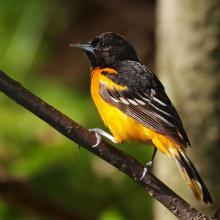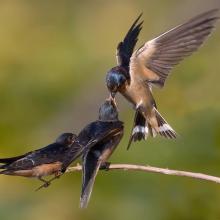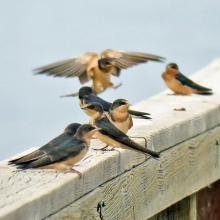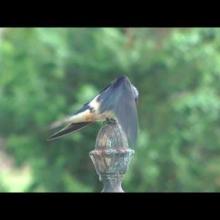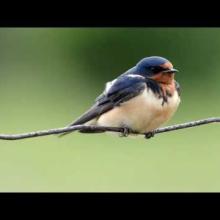

Join BirdNote tomorrow, November 30th!
Illustrator David Sibley and actor H. Jon Benjamin will face off in the bird illustration battle of the century during BirdNote's Year-end Celebration and Auction!
Every year, hundreds of bird species migrate between North and South America. Some species likely evolved from ancestors that moved north in search of new breeding habitats: the “southern home” hypothesis. But others may have extended their winter ranges south: the “northern home” hypothesis. Many birds have likely gained and lost the ability to migrate multiple times over the course of evolution. And it’s still happening today.
BirdNote®
Which Came First: North- or South-bound Migration?
Written by Ariana Remmel
This is BirdNote.
Every year, hundreds of bird species migrate between North and South America. But what came first: north-bound migration? Or south-bound migration?
[Baltimore Oriole song, https://macaulaylibrary.org/asset/219606]
Biologists believe this bright orange Baltimore Oriole descended from a South American ancestor that began migrating north in search of new breeding habitats. This supports the “southern home” hypothesis, that most birds originated in a southern territory and then evolved to migrate north.
[Yellow Warbler, https://macaulaylibrary.org/asset/516692, 0:04-0:05]
But there’s a “northern home” hypothesis, too. The family tree of warblers in the Western Hemisphere shows that most of these songbirds likely originated in North America, then evolved to extend their winter range by migrating south.
Many birds have likely gained and lost the ability to migrate multiple times in either direction over the course of their evolutionary history. And it’s still happening today.
[Barn Swallow calls, https://macaulaylibrary.org/asset/304238]
Barn Swallows normally breed across North America before spending their winters in the tropics. But recently, a small group of these acrobatic birds began staying in Argentina year round. Researchers suspect that, given enough time, they could eventually become a genetically distinct subspecies of their own.
For BirdNote, I’m Michael Stein.
###
Senior Producer: John Kessler
Production Manager: Allison Wilson
Producer: Mark Bramhill
Associate Producer: Ellen Blackstone
Digital Producer: Conor Gearin
Bird sounds provided by The Macaulay Library of Natural Sounds at the Cornell Lab of Ornithology, Ithaca, New York. Baltimore Oriole ML 219606 recorded by B. McGuire, Yellow Warbler ML 516692 recorded by W. Hershberger, and Barn Swallow ML 304238 recorded by P. Boesman.
BirdNote’s theme was composed and played by Nancy Rumbel and John Kessler.
© 2021 BirdNote October 2021 Narrator: Michael Stein
ID# migration-37-2021-10-11 migration-37




